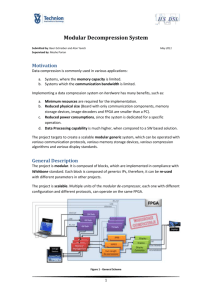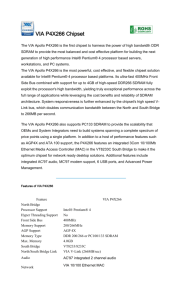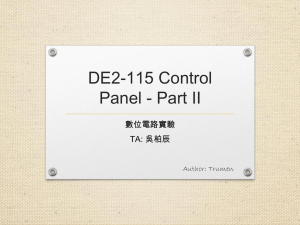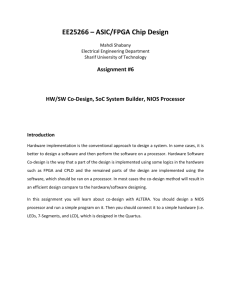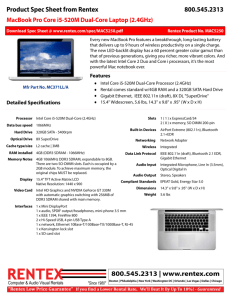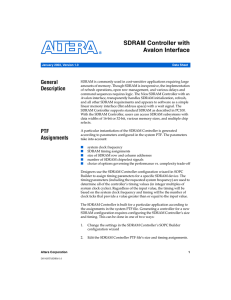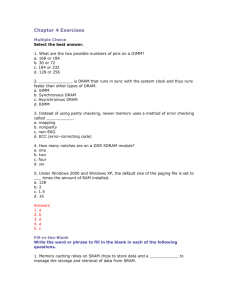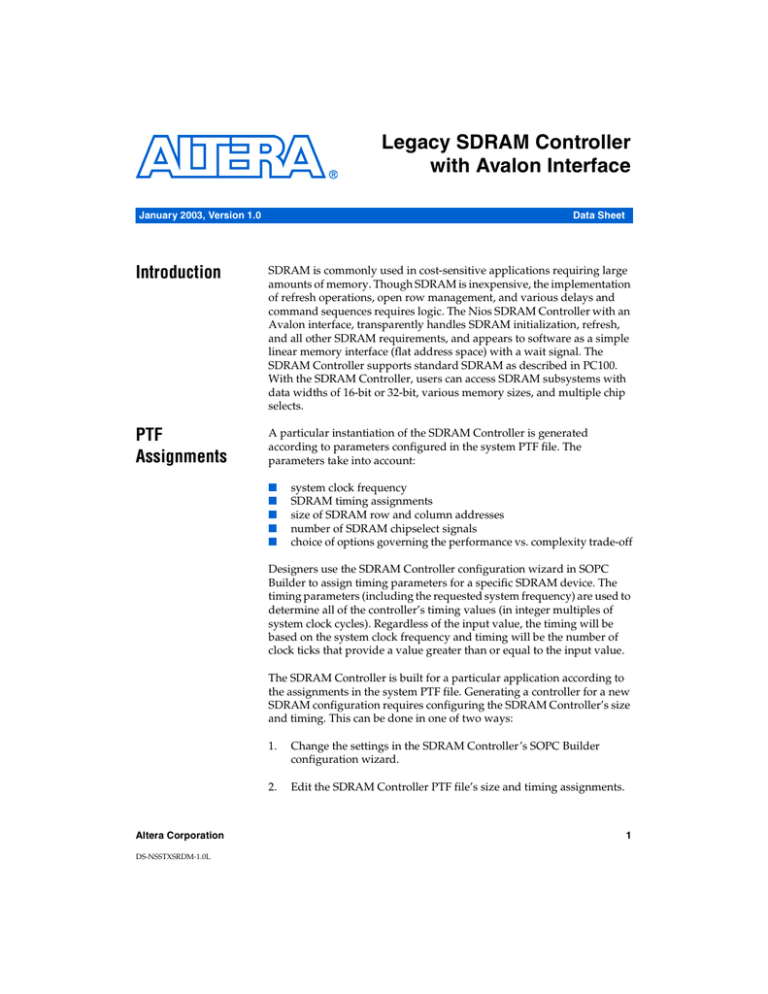
Legacy SDRAM Controller
with Avalon Interface
January 2003, Version 1.0
Data Sheet
Introduction
SDRAM is commonly used in cost-sensitive applications requiring large
amounts of memory. Though SDRAM is inexpensive, the implementation
of refresh operations, open row management, and various delays and
command sequences requires logic. The Nios SDRAM Controller with an
Avalon interface, transparently handles SDRAM initialization, refresh,
and all other SDRAM requirements, and appears to software as a simple
linear memory interface (flat address space) with a wait signal. The
SDRAM Controller supports standard SDRAM as described in PC100.
With the SDRAM Controller, users can access SDRAM subsystems with
data widths of 16-bit or 32-bit, various memory sizes, and multiple chip
selects.
PTF
Assignments
A particular instantiation of the SDRAM Controller is generated
according to parameters configured in the system PTF file. The
parameters take into account:
■
■
■
■
■
system clock frequency
SDRAM timing assignments
size of SDRAM row and column addresses
number of SDRAM chipselect signals
choice of options governing the performance vs. complexity trade-off
Designers use the SDRAM Controller configuration wizard in SOPC
Builder to assign timing parameters for a specific SDRAM device. The
timing parameters (including the requested system frequency) are used to
determine all of the controller’s timing values (in integer multiples of
system clock cycles). Regardless of the input value, the timing will be
based on the system clock frequency and timing will be the number of
clock ticks that provide a value greater than or equal to the input value.
The SDRAM Controller is built for a particular application according to
the assignments in the system PTF file. Generating a controller for a new
SDRAM configuration requires configuring the SDRAM Controller’s size
and timing. This can be done in one of two ways:
Altera Corporation
DS-NSSTXSRDM-1.0L
1.
Change the settings in the SDRAM Controller’s SOPC Builder
configuration wizard.
2.
Edit the SDRAM Controller PTF file’s size and timing assignments.
1
Legacy SDRAM Controller with Avalon Interface Data Sheet
f
See the SOPC Builder Data Sheet for more information about the SOPC
Builder configuration wizards and see the SOPC Builder PTF File Reference
Manual for PTF file assignment details.
Tables 1 through Table 4 on page 3 list the SDRAM Controller PTF
parameters. All of these parameters are located in the system PTF’s
MODULE/WIZARD_SCRIPT_ARGUMENTS section.
Table 1. Memory Size
Parameter
Type
Allowed
Values
Defaul Units
t
Description
sdram_data_width
Integer
8, 16, 32
32
bits
SDRAM data bus width.
sdram_addr_width
Integer
(*)
11
bits
Number of SDRAM address pins. Normally the
same as sdram_row_width.
sdram_bank_width
Integer
2
2
bits
Number of SDRAM bank address pins. Must be
2 (4 banks).
sdram_num_chipselects
Integer
1, 2, 4
1
bits
Number of independent chip selects in the
SDRAM system.
Table 2. Memory Layout
Parameter
Type
Allowed Values Default Units
Description
sdram_row_width Integer
≥ 11
11
bits
Number of row address bits. This value
depends on SDRAM geometry. For example,
an SDRAM organized as 4096 rows by 512
columns has sdram_row_width = 12.
sdram_col_width
≥8
and
8
bits
Number of column address bits. For example,
the SDRAM organized as 4096 rows by 512
columns has sdram_col_width = 9.
Integer
< sdram_row_width
Table 3. Timing (Part 1 of 2)
Parameter
Type
Allowed
Values
refresh_period
Floating
Point
(*)
15.625
µs
One refresh command is executed each
refresh_period. A typical SDRAM requires 4096
refresh commands every 64ms, which can be
met by issuing one refresh command every
64ms / 4096 = 15.625µs.
powerup_delay
Floating
Point
(*)
100
µs
The delay from stable clock and power to
SDRAM initialization.
2
Default Units
Description
Altera Corporation
Legacy SDRAM Controller with Avalon Interface Data Sheet
Table 3. Timing (Part 2 of 2)
Parameter
Type
Allowed
Values
Default Units
Description
cas_latency
Integer
1, 2
1
t_rfc
Floating
Point
(*)
70
ns
Auto-refresh period.
t_rp
Floating
Point
(*)
20
ns
PRECHARGE command period.
t_mrd
Floating
Point
(*)
2
t_rcd
Floating
point
(*)
20
ns
ACTIVE to READ or WRITE delay.
t_ac
Floating
point
(*)
17
ns
Access time from clock edge. This value may
depend on CAS latency.
t_wr_precharge
Floating
point
(*)
14
ns
Write recovery if explicit PRECHARGE
commands are issued (highperf = 1).
init_refresh_commands
Integer
(*)
2
clock Latency in clocks from a READ command to
cycles data out. Typical SDRAM chips support CAS
latency of 2 or 3; rare examples also support
CAS latency = 1. For best performance, use the
lowest CAS latency possible, but beware of
increased t_AC at lower CAS latencies.
clocks LOAD MODE REGISTER command to ACTIVE
or REFRESH command. JEDEC and PC100
specify 3 clocks; other parts accept 2 clocks.
The number of refresh commands required
during initialization. The SDRAM controller logic
is minimized by smaller values of this
parameter.
Table 4. Advanced
Parameter
Type
Allowed
Values
init_nop_delay
Floating
point
(*)
0
µs
The required delay after the first NOP
command during initialization. Other parts
require no additional delay.
enable_ifetch
Boolean
0
0
–
Reserved for future use.
shared_data
Boolean
0
0
–
Requires tri-state bus bridge.
(*)
Defaul Units
t
Description
The correct values depend upon the information provided in the SDRAM manufacturer’s data sheet.
Altera Corporation
3
Legacy SDRAM Controller with Avalon Interface Data Sheet
Examples
The following examples show how to connect the SDRAM controller
outputs to an SDRAM chip or chips. The bus labeled ctl is an aggregate
of the signals cas_n, ras_n, cke and we_n.
Figure 1 shows a single 128 Mbit SDRAM chip with 32-bit data. Address,
data and control signals are wired directly from the controller to the chip.
The result is a 128Mbit (16Mbyte) memory space.
Figure 1. Single 128 Mbit SDRAM Chip with 32-Bit data
addr
ctl
cs_n
128 Mbits
16 Mbytes
32 data width device
32
data
Figure 2 shows two 64Mbit SDRAM chips, each with 16-bit data. Address
and control signals wire in parallel to both chips. Note that chipselect
(cs_n) is shared by the chips. Each chip provides half of the 32-bit data
bus. The result is a logical 128Mbit (16Mbyte) 32-bit data memory.
Figure 2. Two 64Mbit SDRAM Chips each with 16-Bit Data
addr
ctl
cs_n
64 Mbits
8 Mbytes
16 data width device
16
64 Mbits
8 Mbytes
16 data width device
16
32
data
Figure 3 shows two 128Mbit SDRAM chips, each with 32-bit data. Control,
address and data signals wire in parallel to the two chips. The chipselect
bus (cs_n[1:0]) determines which chip is selected. The result is a logical
256Mbit 32-bit wide memory.
4
Altera Corporation
Legacy SDRAM Controller with Avalon Interface Data Sheet
Figure 3. Two 128Mbit SDRAM Chips each with 32-Bit Data
addr
ctl
cs_n [0]
128 Mbits
16 Mbytes
32 data width device
32
cs_n [1]
128 Mbits
16 Mbytes
32 data width device
32
32
data
Altera Corporation
5
Legacy SDRAM Controller with Avalon Interface Data Sheet
101 Innovation Drive
San Jose, CA 95134
(408) 544-7000
http://www.altera.com
Applications Hotline:
(800) 800-EPLD
Literature Services:
lit_req@altera.com
6
Copyright © 2003 Altera Corporation. All rights reserved. Altera, The Programmable Solutions Company, the
stylized Altera logo, specific device designations, and all other words and logos that are identified as
trademarks and/or service marks are, unless noted otherwise, the trademarks and service marks of Altera
Corporation in the U.S. and other countries. All other product or service names are the property of their
respective holders. Altera products are protected under numerous U.S. and foreign patents and pending
applications, mask work rights, and copyrights. Altera warrants performance of its
semiconductor products to current specifications in accordance with Altera’s standard
warranty, but reserves the right to make changes to any products and services at any time
without notice. Altera assumes no responsibility or liability arising out of the application
or use of any information, product, or service described herein except as expressly agreed
to in writing by Altera Corporation. Altera customers are advised to obtain the latest
version of device specifications before relying on any published information and before
placing orders for products or services.
Altera Corporation

